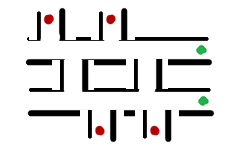OPTIONAL ALTERNATIVES - A DIFFERENT SUBSTITUTE
Posts
Pages:
1
So most exploration design in games basically boil down to this: You take the optimal path forward to where the next story/progress beat is, but evidently there are alternate routes to find all the extra goodies you can before moving on. These can either manifest in giving more power/items to the player or simply filling out a checklist (prefebably a stamp collection that makes a satisfying ding noise). You may not be 100%ing the game, but I feel players are always conditioned to check the dead ends almost every time. Pretty much any game with a character that explores an environment follows this format, even games that probably don't need it (ones that have a lot of "place of no return" bs). I don't actually want to discuss the pros/cons or merits of all of this.
What I want is to basically discuss/brain-storm any potential ideas for a game (structure wise) that actually feels different to play. When I say structure wise I mean when you're making a map or a level, how they're not only laid out but also how they connect. The litmus test being, if you can play this hypothetical game without once wavering between 100%ing or minimally beating the game. The biggest wrench in this if your game is on a platform with achievements or that players find a way to make their own fun (replaying the game for exterior reasons), but lets just assume that isn't a problem.
I'll knock out perhaps the obvious:
The game is actually linear. In a sense there's no reason to go back to a place before moving on, there's still a variety of ways to get through an area (due to the nature of obstacles and enemy AI) so it's only linear in that a hallway is. Some early NES platformers may follow this (but even they had scoring methods or optional life pick ups at times).
The optional stuff is the optimal path. On the other end of the extreme is that everything can literally be played out of order, but every collectible spotted is mandatory. Open world games do this to an extent but they also have an excess amount of optional stuff to boot. I'm imagining an absolute "you're supposed to check that waterfall" design however. Collect the 7 magical crystals, but that's the only thing you actually collect etc.
Pick one path, miss others Take your Star-Fox or classic Castlevania. The levels/segments are linear on their own, but at the end of each one you pick the next level (let's say 2A), but you forgo playing 2B or 2C. There's no collectible reason for this, other than maybe a certain level is easier or you just prefer a gimmicky level over the more vanilla one. The first thing comes to mind is arcade games, but this can also be applied to choices in WRPG/story games. Though some of them ultimately become collectathons in how many possibilities you can find or unlock. A game with options, but every one of them locks out others.
Any ideas or any existing games you feel goes against the optimal+optional trend or philosphy would be appreciated. Again, don't want to really talk about whether these are actually good/bad, but if there's something fundamentally different out there or another design mindset . Maybe this is all there is to it and most games are a blend of these extremes. I don't know how else to frame this topic other than to please just go galaxy brain as much as you can.
What I want is to basically discuss/brain-storm any potential ideas for a game (structure wise) that actually feels different to play. When I say structure wise I mean when you're making a map or a level, how they're not only laid out but also how they connect. The litmus test being, if you can play this hypothetical game without once wavering between 100%ing or minimally beating the game. The biggest wrench in this if your game is on a platform with achievements or that players find a way to make their own fun (replaying the game for exterior reasons), but lets just assume that isn't a problem.
I'll knock out perhaps the obvious:
The game is actually linear. In a sense there's no reason to go back to a place before moving on, there's still a variety of ways to get through an area (due to the nature of obstacles and enemy AI) so it's only linear in that a hallway is. Some early NES platformers may follow this (but even they had scoring methods or optional life pick ups at times).
The optional stuff is the optimal path. On the other end of the extreme is that everything can literally be played out of order, but every collectible spotted is mandatory. Open world games do this to an extent but they also have an excess amount of optional stuff to boot. I'm imagining an absolute "you're supposed to check that waterfall" design however. Collect the 7 magical crystals, but that's the only thing you actually collect etc.
Pick one path, miss others Take your Star-Fox or classic Castlevania. The levels/segments are linear on their own, but at the end of each one you pick the next level (let's say 2A), but you forgo playing 2B or 2C. There's no collectible reason for this, other than maybe a certain level is easier or you just prefer a gimmicky level over the more vanilla one. The first thing comes to mind is arcade games, but this can also be applied to choices in WRPG/story games. Though some of them ultimately become collectathons in how many possibilities you can find or unlock. A game with options, but every one of them locks out others.
Any ideas or any existing games you feel goes against the optimal+optional trend or philosphy would be appreciated. Again, don't want to really talk about whether these are actually good/bad, but if there's something fundamentally different out there or another design mindset . Maybe this is all there is to it and most games are a blend of these extremes. I don't know how else to frame this topic other than to please just go galaxy brain as much as you can.
This is something that I've been thinking alot, especially since the "guess which path leads to plot and which leads to loot" structure is so overdone, but I could never come up with an answer.
The litmus test of "if you can play this hypothetical game without once wavering between 100%ing or minimally beating the game" is hard to pass, but it really got me thinking about it.
My first thought went to roguelikes, but that's not actually different than the original idea. It's just "do I take the stairs to the next level or risk trying to grab the items" though while the risk of permadeath does make collecting the items more risky, it still does nothing to answer the question.
My next thought was "what if every door in a dungeon locked behind you, but they all eventually led to the boss?" That would potentially prevent poking around every corner and make the player just go for it, but in essence it's basically just the "Pick One Path" methodology applied to levels themselves.
Frustrating as it is, I'm not able to come up with anything more right now, but I'm pretty out of it so I think I'll sleep on it and keep thinking. Looking forward to seeing what everyone else brainstorms up! :DDD
The litmus test of "if you can play this hypothetical game without once wavering between 100%ing or minimally beating the game" is hard to pass, but it really got me thinking about it.
My first thought went to roguelikes, but that's not actually different than the original idea. It's just "do I take the stairs to the next level or risk trying to grab the items" though while the risk of permadeath does make collecting the items more risky, it still does nothing to answer the question.
My next thought was "what if every door in a dungeon locked behind you, but they all eventually led to the boss?" That would potentially prevent poking around every corner and make the player just go for it, but in essence it's basically just the "Pick One Path" methodology applied to levels themselves.
Frustrating as it is, I'm not able to come up with anything more right now, but I'm pretty out of it so I think I'll sleep on it and keep thinking. Looking forward to seeing what everyone else brainstorms up! :DDD
LockeZ

I'd really like to get rid of LockeZ. His play style is way too unpredictable. He's always like this too. If he ran a country, he'd just kill and imprison people at random until crime stopped.
5958
I can definitely imagine a game where the exploration revolved around not just wandering and walking around, but solving puzzles, noticing small clues, investigating objects, figuring out riddles, and interacting with the environment in a wide variety of ways. In terms of gameplay, this exploration could resemble anything from Myst, to Monkey Island, to Maniac Mansion, to a trap-filled D&D dungeon, to La Mulana, to Legend of Zelda, to a hidden pictures game. The main thing is that there needs to be LOTS of different ways to interact with the environment, and they need to not all be immediately obvious. The player has to constantly be trying to figure out what part of the environment to interact with, and also what exactly to do with it.
But the real key here, to make it different in the way Darken is talking about, would be that figuring out these puzzles would be mandatory. None of them would lead to secrets. Instead they'd just lead further into the game. But there would also be a lot of dead end traps, for players who misunderstood the puzzle or the environment and went the wrong way or did the wrong thing. If you solve a puzzle wrong, bam, you spring a trap. If you go through a door without figuring out the clue that the door is fake, same thing happens. You take a poison dart to the face, or you fall in a spike trap, or you spawn an enemy, or whatever. And this damage would probably make the battles, and especially the boss fight at the end of the dungeon, a lot harder. Or if the game doesn't have battles, then faceplanting into a trap would instead lower the player's score, and maybe reduce the rewards they get at the end of the stage.
In this kind of model, the game is still about exploration. More than ever before, really, since the exploration is now mandatory. But going the wrong way doesn't net you hidden rewards. It nets you a punishment, because that's the wrong way.
It would be vitally important in a game like this that the "right way" would always be something players should be able to figure out. Preferably by some combination of thinking hard about it and noticing enough details as they explore, rather than JUST by thinking about it, because having to find and notice lots of little details is a big part of what would make this into an exploration game.
I can think of a lot of games that do everything I said above. La Mulana and Legend of Zelda, for example. Those games just all typically also reward you with treasure sometimes for going a certain wrong way and finding a hidden secret. But you could strip all that out and make every single secret lead to mandatory progress.
Certain Sierra/LucasArts adventure games kinda almost do the above. You could probably convert one of them into this idea by adding a bunch of penalties for wrong answers. As they are, guessing the wrong answer in those games usually just results in "I can't do that." Or an in immediate game over if you're playing the original Maniac Mansion.
But the real key here, to make it different in the way Darken is talking about, would be that figuring out these puzzles would be mandatory. None of them would lead to secrets. Instead they'd just lead further into the game. But there would also be a lot of dead end traps, for players who misunderstood the puzzle or the environment and went the wrong way or did the wrong thing. If you solve a puzzle wrong, bam, you spring a trap. If you go through a door without figuring out the clue that the door is fake, same thing happens. You take a poison dart to the face, or you fall in a spike trap, or you spawn an enemy, or whatever. And this damage would probably make the battles, and especially the boss fight at the end of the dungeon, a lot harder. Or if the game doesn't have battles, then faceplanting into a trap would instead lower the player's score, and maybe reduce the rewards they get at the end of the stage.
In this kind of model, the game is still about exploration. More than ever before, really, since the exploration is now mandatory. But going the wrong way doesn't net you hidden rewards. It nets you a punishment, because that's the wrong way.
It would be vitally important in a game like this that the "right way" would always be something players should be able to figure out. Preferably by some combination of thinking hard about it and noticing enough details as they explore, rather than JUST by thinking about it, because having to find and notice lots of little details is a big part of what would make this into an exploration game.
I can think of a lot of games that do everything I said above. La Mulana and Legend of Zelda, for example. Those games just all typically also reward you with treasure sometimes for going a certain wrong way and finding a hidden secret. But you could strip all that out and make every single secret lead to mandatory progress.
Certain Sierra/LucasArts adventure games kinda almost do the above. You could probably convert one of them into this idea by adding a bunch of penalties for wrong answers. As they are, guessing the wrong answer in those games usually just results in "I can't do that." Or an in immediate game over if you're playing the original Maniac Mansion.
I like the idea of a game that expands when you explore and that the endgoal is the exploration itself. When you get sick of exploring is when your game ends.
Or something that has a specific amount of time. Every way is the right way to go, there is no over-arching story, everything is randomised and useful and the journey and what you learn on the way is the main aim of the game.
Minecraft is this kind of game, really. The game is what you make of it - it can be creatively making stuff or challenging yourself to a hardcore run or just exploring the world and finding what you find. Sure, there are chests and items hidden around, but they're procedurally generated and random, and you're as likely to stumble on them just running around doing whatever as you are by actively trying to find them.
As for a more story-based type of game, it could work in the same way if the backwards route is blocked off or if you're allowed to change the story road you're on at any point just by backtracking and picking another path. Not sure I can think of a game that allows for the second - a rewind or overwrite mechanic would be needed.
I like the idea of a game where what you unlock over the course of your journey dictates what you know of the game. Every way is plausible and will give you story, but you'll get a clearer picture if you look into it more than you do if you take one path or only run around. Granted, it'd have to be very ambiguous and yet fitting a story to fit and feel right at the 'end', and it does fall into the trap of "one try doesn't get the full experience, so play again".
Or something that has a specific amount of time. Every way is the right way to go, there is no over-arching story, everything is randomised and useful and the journey and what you learn on the way is the main aim of the game.
Minecraft is this kind of game, really. The game is what you make of it - it can be creatively making stuff or challenging yourself to a hardcore run or just exploring the world and finding what you find. Sure, there are chests and items hidden around, but they're procedurally generated and random, and you're as likely to stumble on them just running around doing whatever as you are by actively trying to find them.
As for a more story-based type of game, it could work in the same way if the backwards route is blocked off or if you're allowed to change the story road you're on at any point just by backtracking and picking another path. Not sure I can think of a game that allows for the second - a rewind or overwrite mechanic would be needed.
I like the idea of a game where what you unlock over the course of your journey dictates what you know of the game. Every way is plausible and will give you story, but you'll get a clearer picture if you look into it more than you do if you take one path or only run around. Granted, it'd have to be very ambiguous and yet fitting a story to fit and feel right at the 'end', and it does fall into the trap of "one try doesn't get the full experience, so play again".
Let's remember there's also the "Change the path once you die" mechanic employed in games such as Dead Cells or Stanley Parable. If you haven't played those, basically, you die/end game a lot in these games. Once you restart however, the entire map changes.
While Dead Cells is more rogue-like, I like how in Stanley Parable, the game changes permanently depending on what you did before.
Perhaps in your game you can change the path entirely on each run through?
While Dead Cells is more rogue-like, I like how in Stanley Parable, the game changes permanently depending on what you did before.
Perhaps in your game you can change the path entirely on each run through?
Aight so here's a crappy ms paint chart detailing the possibilities of how a game's flow works. The green represents progress, moving on to the next area, the ending to the game, or essentially some form of change. The blues are optional stuff, are positives but something you don't need and don't advance anything, though in the second column's exception case the rule is that if you get all the blues you essentially get a green. Reds are a negative or a gameover, like a mimic chest or a mean ol dart trap. I would have considered them blues as well but LockeZ's post made me decide to make the distinction because there's a pretty good case for how the player behavior reacts differently to diverging paths.

First column is pretty much every modern game ever. Going to a green forwards the story, getting the blues (either at any time or before you get the green) gives you bonuses or fills your checklist.
2nd Column assumes that getting every blue forwards the story (this does appear in game objectives or broad goals, but I've rarely seen a game that strictly adheres to this unless 100%ing games are mandatory to you)
3rd column is basically, you pick one green you miss out on the other greens. Go to the near area missing everything or get an ending of the game. Functionally it could act like the 2nd if you're willing to play the game over and over, but again it depends on how the game is intended to be played. Groundhog day games like Majora's follow this sort of formula as well. I put the linear segment because I didn't know where else to put it (but it also just fits in the greens only category).
4th column we bring in traps and game overs. I would say Shadowgate follows this formula, in which you're sometimes curious to find all the possible ways to die, or at the very least enjoy the trial and error. There's a bit of a mistake though, I meant to put one green, but alternatively I guess multiple greens is a little more interesting.
5th column, maybe... a dead end is just a dead end? In real life there is usually no significance in something like an alley way even if there is a given purpose for someone out there. In old RPGs dead ends were used to prolong the random encounter rate but also I think mazes were just fun to people back then. In Control there's a mind bending maze that is a modern reflection of this.

The 6th column, well is probably a very depressing game in which everything is either a game over or a bad ending depending on how you look at it. A game where you cannot win but some people would argue "survival is winning" or that bad endings could merely be a goal/green.
Is there anything that could be added? A new color or a new structure perhaps? Or some variant of these that actually makes you rethink how a game could be played or charted. There are some things I don't know how to chart like Minecraft (that Liberty mentioned) although that game does have an ending I do see her point of how procedural content manifests endlessly.

First column is pretty much every modern game ever. Going to a green forwards the story, getting the blues (either at any time or before you get the green) gives you bonuses or fills your checklist.
2nd Column assumes that getting every blue forwards the story (this does appear in game objectives or broad goals, but I've rarely seen a game that strictly adheres to this unless 100%ing games are mandatory to you)
3rd column is basically, you pick one green you miss out on the other greens. Go to the near area missing everything or get an ending of the game. Functionally it could act like the 2nd if you're willing to play the game over and over, but again it depends on how the game is intended to be played. Groundhog day games like Majora's follow this sort of formula as well. I put the linear segment because I didn't know where else to put it (but it also just fits in the greens only category).
4th column we bring in traps and game overs. I would say Shadowgate follows this formula, in which you're sometimes curious to find all the possible ways to die, or at the very least enjoy the trial and error. There's a bit of a mistake though, I meant to put one green, but alternatively I guess multiple greens is a little more interesting.
5th column, maybe... a dead end is just a dead end? In real life there is usually no significance in something like an alley way even if there is a given purpose for someone out there. In old RPGs dead ends were used to prolong the random encounter rate but also I think mazes were just fun to people back then. In Control there's a mind bending maze that is a modern reflection of this.

The 6th column, well is probably a very depressing game in which everything is either a game over or a bad ending depending on how you look at it. A game where you cannot win but some people would argue "survival is winning" or that bad endings could merely be a goal/green.
Is there anything that could be added? A new color or a new structure perhaps? Or some variant of these that actually makes you rethink how a game could be played or charted. There are some things I don't know how to chart like Minecraft (that Liberty mentioned) although that game does have an ending I do see her point of how procedural content manifests endlessly.
author=Darken
The 6th column, well is probably a very depressing game in which everything is either a game over or a bad ending depending on how you look at it. A game where you cannot win but some people would argue "survival is winning" or that bad endings could merely be a goal/green.
I just wanna chime in here since I think this topic is interesting and I've played a 6th column game:
Column 6, sounds a lot like the Clocktower games. Specifically Clock Tower:Gaiden/Clock Tower 2: The Struggle Within.
Where (unless you know very specifically, what to do in the very first level) every playthrough will lead you to a dead end, bad ending:
-You'll die in the house, can't progress any further and have to restart the game from the beginning.
-there's variations of each death within the house, further limiting your branches:
i.e. you'll die on the roof, make it pass the roof, die in the bathroom, make it pass the bathroom, die in the bedroom.
delete your save file, restart the game
-You'll survive the house, but you'll die in the hospital, can't progress any further and have to restart from the beginning.
-there's variations of each death that happens within the hospital, further limiting those branches.(same as above)
-You'll make it pass the house and the hospital, but because you missed something in the house, you can't progress any further, die and have to restart from the beginning.
-You'll make it pass the house and the hospital, you found what you needed from the house and progress further, but because you missed something from the hospital, you can't progress any further, die and have to restart from the very beginning.
-You make it pass the house, pass the hospital, found what you needed from the house, found what you needed from the hospital, it's near the end of the game.
The game branches off between 3 distinct routes depending on what you do in this final act:
- one ending is where you die
- one ending is where your friend dies, but you live
- one ending is where you both live but the enemy dies.
Clock Tower 2:The Struggle Within
was probably one of the worst games I played through. It's the only game where I found myself literally, contemplating my life choices, and trying to think of millions of other things I could be doing with my time, other than playing this game. Because, I'd make it up to a certain point in the game, only to find out it was a complete dead end. But these dead ends, are things you're not even aware of, while you're still trying to figure out the game - Like taking the door on the right, at the very beginning of the game and taking the red piece of paper out of the office desk. Or taking the samurai helmet off the statue on the 2nd floor immediately, after getting access to that part of the game. These are things you would only know to do, if you were looking at a walkthrough. - It's not like Resident Evil or Silent Hill, where there's a very definite point of no return. These are very minute decisions. There's no way the player would be able to figure these things out on their own through multiple playthroughs, because the game doesn't even allow for experimentation. -- It would've been cooler if there was some indication that, these minute choices, at particular points in the game actually do matter, so the player could start to experiment with them and actually explore them.
...But yeah, aside from how frustrating this was to playthrough, I thought it was really interesting how, the game branches off into several different and numerous bad endings. It's kind of almost like this spiderweb, where you work your way up to the perfect ending, where you actually do feel, a true sense of accomplishment, like you actually survived a horror movie by getting the perfect ending, because you've witnessed how many ways, things could've went wrong - But yeah, make no mistake, this wasn't fun to playthrough at all.
I think playing around with structure in video games is fun - but after a certain point, playing through, said actually structure, isn't really all that fun to playthrough - like even in arcade games like Metal Slug 3 or Space Ace, I don't find myself purposely replaying these games to find a specific route, unless I want to see everything that game has to offer. Most of the time, I just choose the best route and just replay those best scenes over and over again.
But yeah, I can't think of any variations of this structure to add.
But if you want to see a 6th column game. Check out ClockTower 2: The Struggle Within. In order to understand how frustrating this game plays with structure, You'll have to play through it. it's not something you can watch from a youtube video. It's like working so hard, to get to a certain point of the game, only to realize it's another dead end. I'm making it sound better than it actually is - It's not fun, it's not fun at all. It's like losing all your progress during a thunderstorm and having to start over: the game.
Great thread here Darken!♥
Red_Nova

Sir Redd of Novus: He who made Prayer of the Faithless that one time, and that was pretty dang rad! :D
9192
The only structures I can think of are various unholy amalgamations of the structures already listed out. Final Fantasy XV, for example, was structured something like this:

You can move between the open world and hallway section after a certain amount of time in the hallway, but once you start to go down that hallway, that becomes the new forward progress for the rest of the game. If you're feeling dangerous, then you could open it up by giving players several hallways to choose from:

If you're feeling particularly mean, feel free to replace one of the ending green dots with a red one.
Radiant Historia attempted a structure akin to this:

Here, you have two hallways that you could swap between at will. It's not exactly a branching path because these hallways are two very distinct storylines that have their own beginnings, middles, and conclusions, and you must complete both of them to finish the game. Moments in each storyline required you to either make choices that could result in progress or a bad end, or slam you against a wall and require you to jump to the other hallway and make progress there.

You can move between the open world and hallway section after a certain amount of time in the hallway, but once you start to go down that hallway, that becomes the new forward progress for the rest of the game. If you're feeling dangerous, then you could open it up by giving players several hallways to choose from:

If you're feeling particularly mean, feel free to replace one of the ending green dots with a red one.
Radiant Historia attempted a structure akin to this:

Here, you have two hallways that you could swap between at will. It's not exactly a branching path because these hallways are two very distinct storylines that have their own beginnings, middles, and conclusions, and you must complete both of them to finish the game. Moments in each storyline required you to either make choices that could result in progress or a bad end, or slam you against a wall and require you to jump to the other hallway and make progress there.
LockeZ

I'd really like to get rid of LockeZ. His play style is way too unpredictable. He's always like this too. If he ran a country, he'd just kill and imprison people at random until crime stopped.
5958
I think this is a pretty good list. I think if you want to make the game more interesting than the small set of choices in Darken's list suggests, you're going to have to do so by combining these structures together and looping them back around on each other to create a more complex map. Or, you're going to have to start making the player choose their path in a more interesting and interactive way than just walking in a different direction.
I do think it's worth counting a unique case where the player has to not only select the right path, but also first discover that it exists. This isn't really a different structure than anything Darken mentioned, but it's another way to differentiate the exploration in two different games that might otherwise seem to use the same option out of Darken's list.

In the original Legend of Zelda, you have to bomb every wall and burn every bush in the entire game. A few bombable walls have moblins inside who make you pay the door repair fee for blowing up their house. Most others have a reward which might be either optional or mandatory. Some things are not hidden, though the non-hidden things are never traps. This is probably the most common structure for hidden paths - having all three types, while also making some mandatory paths be non-hidden.
In a typical section of Super Metroid, there are likely to be a bunch of hidden spots you can find, each by a slightly different method. There's also one mandatory path which is not hidden. The mandatory path often has obstacles that take some time to figure out, but its mere existence is never invisible like the optional rewards are. For example, to complete a mandatory path, you might enter a room have to use your grappling hook in a new way you've never used it before, but to find an optional item you might have to shoot a random tile that looks identical to 800 other tiles in the same room. There are no traps in Super Metroid.
La Mulana is an exercise in frustration for many players - it's a game where every single thing in the game is hidden. Unlike Super Metroid or Legend of Zelda, there's no systematic way to discover these hidden paths - each one is different, often requiring the player to solve what amounts to an invisible puzzle, like "stand in this unmarked spot for 3 minutes" or "fall onto this unmarked tile from as high as possible." And none of these puzzles have even their presence conveyed to the player in an obvious way - in 100% of cases, it's possible to go through a room without even realizing there's something to find. The game conveys what to do via subtle clues that the player must notice and then also interpret, such as "there was a thump sound and it came from the right speaker, so maybe something happened in a room further right" or "this statue's eyes opened, so I should check the room 19 screens back where there was another matching statue."
The Tomb of Horrors is a classic Dungeons & Dragons adventure. A typical room in the Tomb of Horrors has a lot of details, one obvious exit which is (almost) always a trap, and a lot of hidden traps which are punishments for interacting with the wrong detail or doing so in the wrong way. The game uses riddles to try to convey what to do, but interpreting the riddles is difficult. The riddles often only make sense in retrospect (and sometimes not even then). For example, the riddle "If you find the false you find the true" is supposed to convey that when players find a hidden door leading to a dead end with a trap, they can search the dead end (after being impaled with spikes) to find a second hidden door which actually leads to mandatory progress.
Notably, in all of the above games except for Super Metroid, it's possible (in fact, it's very likely) for players to get stuck and simply be unable to complete the game without a walkthrough. I think that is frustrating to a large majority of players, and is why very few games put mandatory objectives behind hidden paths. Modern Metroid and Zelda games heavily de-emphasize even optional hidden paths, having only the occasional bombable wall or hidden grotto that isn't clearly marked. I think it's not a coincidence that Super Metroid is a game people love, Legend of Zelda is a game people tolerate because of its sequels, and the other two games I listed are strongly hated by most players. Most people really do not like hidden mandatory paths. La Mulana has a small niche audience that enjoys it, though. So maybe there are enough people who do like them for an indie developer to capitalize on the fact that AAA games are ignoring that audience.
I do think it's worth counting a unique case where the player has to not only select the right path, but also first discover that it exists. This isn't really a different structure than anything Darken mentioned, but it's another way to differentiate the exploration in two different games that might otherwise seem to use the same option out of Darken's list.

In the original Legend of Zelda, you have to bomb every wall and burn every bush in the entire game. A few bombable walls have moblins inside who make you pay the door repair fee for blowing up their house. Most others have a reward which might be either optional or mandatory. Some things are not hidden, though the non-hidden things are never traps. This is probably the most common structure for hidden paths - having all three types, while also making some mandatory paths be non-hidden.
In a typical section of Super Metroid, there are likely to be a bunch of hidden spots you can find, each by a slightly different method. There's also one mandatory path which is not hidden. The mandatory path often has obstacles that take some time to figure out, but its mere existence is never invisible like the optional rewards are. For example, to complete a mandatory path, you might enter a room have to use your grappling hook in a new way you've never used it before, but to find an optional item you might have to shoot a random tile that looks identical to 800 other tiles in the same room. There are no traps in Super Metroid.
La Mulana is an exercise in frustration for many players - it's a game where every single thing in the game is hidden. Unlike Super Metroid or Legend of Zelda, there's no systematic way to discover these hidden paths - each one is different, often requiring the player to solve what amounts to an invisible puzzle, like "stand in this unmarked spot for 3 minutes" or "fall onto this unmarked tile from as high as possible." And none of these puzzles have even their presence conveyed to the player in an obvious way - in 100% of cases, it's possible to go through a room without even realizing there's something to find. The game conveys what to do via subtle clues that the player must notice and then also interpret, such as "there was a thump sound and it came from the right speaker, so maybe something happened in a room further right" or "this statue's eyes opened, so I should check the room 19 screens back where there was another matching statue."
The Tomb of Horrors is a classic Dungeons & Dragons adventure. A typical room in the Tomb of Horrors has a lot of details, one obvious exit which is (almost) always a trap, and a lot of hidden traps which are punishments for interacting with the wrong detail or doing so in the wrong way. The game uses riddles to try to convey what to do, but interpreting the riddles is difficult. The riddles often only make sense in retrospect (and sometimes not even then). For example, the riddle "If you find the false you find the true" is supposed to convey that when players find a hidden door leading to a dead end with a trap, they can search the dead end (after being impaled with spikes) to find a second hidden door which actually leads to mandatory progress.
Notably, in all of the above games except for Super Metroid, it's possible (in fact, it's very likely) for players to get stuck and simply be unable to complete the game without a walkthrough. I think that is frustrating to a large majority of players, and is why very few games put mandatory objectives behind hidden paths. Modern Metroid and Zelda games heavily de-emphasize even optional hidden paths, having only the occasional bombable wall or hidden grotto that isn't clearly marked. I think it's not a coincidence that Super Metroid is a game people love, Legend of Zelda is a game people tolerate because of its sequels, and the other two games I listed are strongly hated by most players. Most people really do not like hidden mandatory paths. La Mulana has a small niche audience that enjoys it, though. So maybe there are enough people who do like them for an indie developer to capitalize on the fact that AAA games are ignoring that audience.
In the entire continuum of Romancing SaGa games, every battle is a green dot, and everything else is blue.
LockeZ

I'd really like to get rid of LockeZ. His play style is way too unpredictable. He's always like this too. If he ran a country, he'd just kill and imprison people at random until crime stopped.
5958
I suppose there hasn't been much discussion of dead end paths that contain nothing. Probably because they're uninteresting.
Open world games are founded on the idea of adding 99 places with nothing for every actual path that has something, though. And for some reason, a lot of people seem to like that. I guess they're not actually "dead end" paths, since you can go directly from one spot that has nothing to the next, instead of having to backtrack to a main path first. But they're certainly dead locations.
I guess if you have a very generous view of random battles, then putting random battles in your game turns all your pointless dead ends and dead locations into red dots. Is that an improvement...? I'm very much unconvinced that it is. In a typical modern-style open world game, it certainly sounds like an awful addition. It doesn't ever seem like a satisfying solution in JRPG dungeons, either. But it works okay in... hex crawl board games, I guess.
Open world games are founded on the idea of adding 99 places with nothing for every actual path that has something, though. And for some reason, a lot of people seem to like that. I guess they're not actually "dead end" paths, since you can go directly from one spot that has nothing to the next, instead of having to backtrack to a main path first. But they're certainly dead locations.
I guess if you have a very generous view of random battles, then putting random battles in your game turns all your pointless dead ends and dead locations into red dots. Is that an improvement...? I'm very much unconvinced that it is. In a typical modern-style open world game, it certainly sounds like an awful addition. It doesn't ever seem like a satisfying solution in JRPG dungeons, either. But it works okay in... hex crawl board games, I guess.
I'm not sure if someone has already said this, but how about a game where everything is given to the player that they missed?
This idea obviously only works for things like treasure chests; optional story beats or side quests would be a lot harder to wrap together.
It goes a little something like this: there are four paths, and each one gives you a set of treasures as you explore it. At the end, you get the treasures from the paths you didn't take dumped on you. Of course, you had to do the dungeon without those useful items, so the path you take still matters. Maybe you get them after a boss, so the path you take alters how the boss is fought, but you don't actually lose out on anything.
In a game with no shops, different paths would ensure different items combos. Maybe you didn't pick up the Dagger of Fire and have to fight Dungeon 1's boss without it, but don't worry, you'll still have it for Dungeon 2's boss.
You'd miss out on a bit of exploration and have to make up new tactics on the fly, but you wouldn't miss out on any of the rewards associated with exploring.
This idea obviously only works for things like treasure chests; optional story beats or side quests would be a lot harder to wrap together.
It goes a little something like this: there are four paths, and each one gives you a set of treasures as you explore it. At the end, you get the treasures from the paths you didn't take dumped on you. Of course, you had to do the dungeon without those useful items, so the path you take still matters. Maybe you get them after a boss, so the path you take alters how the boss is fought, but you don't actually lose out on anything.
In a game with no shops, different paths would ensure different items combos. Maybe you didn't pick up the Dagger of Fire and have to fight Dungeon 1's boss without it, but don't worry, you'll still have it for Dungeon 2's boss.
You'd miss out on a bit of exploration and have to make up new tactics on the fly, but you wouldn't miss out on any of the rewards associated with exploring.
hmmm... the only other framework that I can think of is massive randomization - random level layouts, random rewards/loot, random enemy placements. A lot of roguelikes (and Diablo and its clones) explore this route. But then you are faced with not so much as a linear path but a treadmill.
I like Darken's thinkpiece threads because they make me feel like I'm too dumb to participate in the discussion. To be clear, this is a 100% unironic statement I'm making.
Way too much of the time--esp. offline and IRL--I have the burden of being the smartest person in the room (or at least thinking I am) and it's exhausting. Feeling like an under-qualified idiot with nothing to say on a topic I should have LOTS to say about is actually a refreshing change.
Way too much of the time--esp. offline and IRL--I have the burden of being the smartest person in the room (or at least thinking I am) and it's exhausting. Feeling like an under-qualified idiot with nothing to say on a topic I should have LOTS to say about is actually a refreshing change.
Pages:
1






















